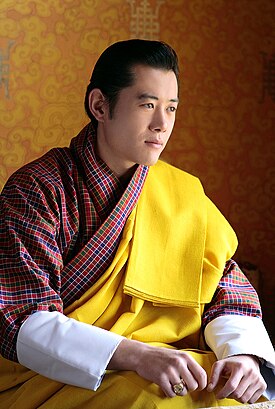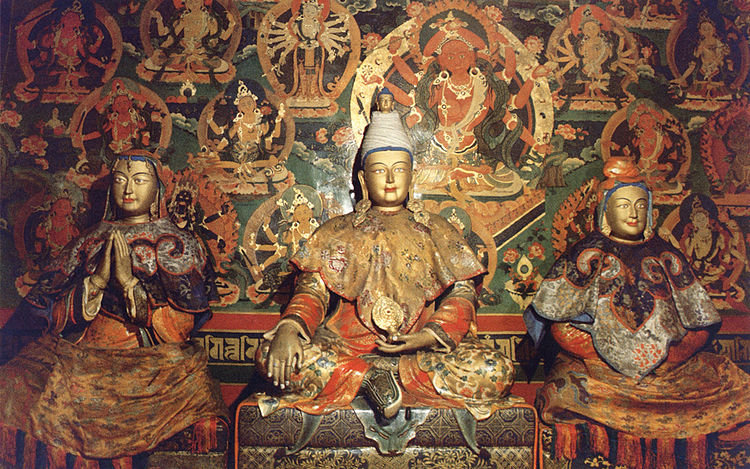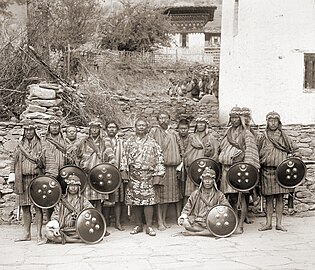Kingdom of Bumthang
Kingdom of Bumthang བུམ་ཐང་ | |
|---|---|
| before 7th century–17th century | |
| Capital | Chakhar Gutho Palace,Jakar Dzong |
| Common languages | Bumthang language,Chöke |
| Religion | Bön,Buddhism |
| Government | Monarchy |
| King (Chogyal) | |
| Historical era | Late Antiquity |
• Established | before 7th century |
•ZhabdrungNgawang Namgyalbegins consolidating control in Bhutan | 1616 |
• Disestablished | 17th century |
• Bumthang nobleJigme Namgyal,forefather of theHouse of Wangchuck,gains control ofTrongsa ProvinceandBumthang Province | 19th century |
TheKingdom of Bumthangwas one of several small kingdoms within the territory of modernBhutanbefore the first consolidation underZhabdrungNgawang Namgyalin 1616. After initial consolidation, the Bumthang Kingdom becameBumthang Province,one of the nineProvinces of Bhutan.The region was roughly analogous to modern-dayBumthang District.It was again consolidated into the modern Kingdom of Bhutan in 1907.
The Kingdom of Bumthang is particularly notable among its many contemporary Bhutanese chiefdoms because it was here thatBuddhismfirst took root inBhutan.The kingdom also contained several places relevant to particularly Bhutanese legends. The kingdom is also the ancestral homeland of theHouse of Wangchuck,which was among local elite families that surpassed the erstwhile Tibetan aristocracy. During Bhutan's early history, Bumthang served as a locus of exile for both Tibetan and Indian rulers, and as the home ofBuddhist saintPema Lingpa.[1]: 13–14
Arrival of Buddhism[edit]
Buddhismwas first introduced to Bhutan in the 7th century AD.TibetankingSongtsän Gampo[2](reigned 627–49), a convert to Buddhism, ordered the construction of two Buddhist temples, atBumthangin central Bhutan and at Kyichu (nearParo) in theParo Valley.[3]
Buddhism replaced but did not eliminate theBönreligious practices that had also been prevalent in Tibet until the late 6th century. Instead, Buddhism absorbed Bön and its believers. As the country developed in its many fertile valleys, Buddhism matured and became a unifying element. It wasBuddhist literatureand chronicles that began the recorded history of Bhutan.[3]
Buddhism was propagated in earnest[2]in 746[4]under King Sindhu Rāja (alsoKünjom;[5]Sendha Gyab; Chakhar Gyalpo), an exiledIndianking who had established a government in Bumthang at Chakhar Gutho Palace.[1]: 13 [6]: 35 The king was engaged in a war against King Nawuchhe, another Indian king to the south, during which the king fell physically ill due to possession by aBöndemon.[4]The king's illness was reportedly brought on by the loss of his son Tala Mebar in the war, and his subsequentabandonmentof his guardian spirit ( "Phola" ) and commission of various impure acts. This caused Seling Karpo, the chief of the Lhaday (gods and demons), to revoke the soul of the king.[6]
Upon the advice of a minor fief, Sindhu Rāja invitedPadmasambhavato exorcise the demon and cure his illness. Upon arrival, the saint requested aTantricconsort (Zungma), and in reply the king offered his daughter Lhachig Bumden Tshomo (Menmo Tashi Kyeden), who possessed twenty-one marks of adakini.[6]After capturing the demon and converting it to Buddhism, Guru Rinpoche cured the Bumthang king. The king himself also converted to Buddhism.[3]and went on to found several pilgrimage sites including Kuje Temple.[6]: 34–5 [7]As a result, many mountains and deities worshipped byBönpawere incorporated into local Buddhism.[8]: 140 [9]
The king's daughter went to live in the cave of Dorji Tsepa, where her Guru meditated. She acted as Dupdemo, whose duty was to fetch water and help the Guru in his religious activities. She came to be known as Machig Bumden ( "single mother" ) because of her reputable religious service.[6]: 34–5
Bumthang in legend[edit]

The Bumthang Kingdom enjoys a place in some of the legends of ancientBhutan.The oldest lies behind a notableJakartemple. Bumthang's Jambey Lhakhang was, according to legend, one of 108[2]temples built in a single night bySongtsen Gampo(605 or 617?–649). Jambey Lhakhang was destroyed by demons who prevented its reconstruction. To drive them off, villagers danced naked under the full moon, causing the demons confusion and panic. To celebrate the legend, a local dancefestivalis held at the Lhakhang yearly.[5][10]
Some later Buddhists in the region laid claim to Buddhist roots predating Buddhism itself, in King Drime Kunden and the prior incarnations ofBuddha,between 2000 and 1000 BC.[8]: 140
The Mo Bar, or Burning Lake, is named for the legend oflamaPema Lingpa,who entered the lake to find aholy treasure,emerging not only with the relic, but with his lamp still burning.[2][10]
Legend also holds that a zealot lama builtchortensalong a road in Bumthang in order to propagateBuddhismin early times. He named each chorten with the suffix -ji,meaning "berry," after bundles of his blessed berries fell along the route.[10]
Consolidation[edit]
The decline of the Kingdom of Bumthang began with the consolidation ofBhutanbyZhabdrung Ngawang Namgyalin 1616. The Zhabdrung, fending off invasions fromTibet,later established effective control of central and eastern Bhutan, including Bumthang, after a series of battles through his lieutenantChogyalMinjur Tenpa (1613–1680;r.1667–1680). Minjur Tenpa was the firstPenlop of Trongsa(Tongsab), appointed by Zhabdrung Ngawang Namgyal. He was born Damchho Lhundrub in Min-Chhud,Tibet,and led a monastic life from childhood. Before his appointment as Tongsab, he held the appointed post of Umzey (Chant Master).[6]: 106
A trusted follower of the Zhabdrung, Minjur Tenpa was sent to subdue kings of Bumthang, Lhuentse, Trashigang, Zhemgang, and other lords fromTrongsa Dzong.After doing so, the Tongsab divided his control in the east among eight regions (Shachho Khorlo Tsegay), overseen by Dungpas and Kutshabs (civil servants). He went on to buildJakar,Lhuentse,Trashigang, and Zhemgang Dzongs. From this time, the status of the independent kingdom was reduced to semi-independentBumthang Province,whosedzongpen(governor) answered toTrongsa.[6]: 106
Legacy[edit]
The legacy of the Kingdom of Bumthang is demonstrated in its religious and political significance in modern Bhutan. The wider Bhutanese nobility, including the modern royalHouse of Wangchuck,emerged from roots in the Bumthang Kingdom.
Bumthang nobility[edit]
The Bumthang nobility constitutes a broad historical upper class in the Bumthang, Kheng, and Mongar (Zhongar) regions. The local term for such noble families isdung(Dzongkha:དུང་/གདུང་;Wylie:dung/gdung;"bone, horn, shell"[11][12]). The two main branches of the nobility are the Ura and Mongar.[8][Notes 1]As such, there are two traditional accounts as to the origin of the nobility: theUraandMongartraditions. Both involve claims of half divine parentage, and merge with the historical figure Lhawang Dragpa, who was from centralTibet.[8]: 182
According to the account fromUra,the kingdom had no heir at the death of King Chikhatharö. As Bumthang subjects quarreled, they also prayed to the God of Heaven. The God of Heaven sent his son, who entered a village woman's womb and was born as Lhagon Pelchen and became king. After three generations, the royal line again extinguished, but not before Lhagon Pelchen's grandson gave instructions on finding his next incarnation. His survivors went to centralTibetand dropped fruit from theMonparegion, kidnapping the child who gathered the most and bringing him back to Ura. This youth became Lhawang Dragpa. As an adult, he looked into his actual origins and found that he was descended from the son ofTibetankingLangdarma.Pleased with his royal pedigree, he remained in Bumthang and married a noblewoman fromTrongsa(Chökhor).[8]: 182
According to theMongaraccount, however the God of Heaven, in the form of a snake, impregnated the betrothed of King Dungsamkha. The offspring took the form of a fish, and was caught in the net of a fisherman who decided to keep him alive upon discovering he could speak. The fish turned into a child while the fisherman was at work, performing chores for his host. While in this form, this fisherman one day threw out the fish skin, leaving the child a human. The half-god was made chief of the region and won control of Ura and Mongar. Before his death, he predicted he would be reincarnated as a child in centralTibetwho would seize the most shells. The child identified was Lhawang Dragpa.[8]: 182
Other independent nobility also took root in Bumthang. These other families are called Shelngo. After the assassination ofLangdarmain 841, the family of his assassin, Lhalung Pelkyi Dorje,[13][14]reportedly fled to Bumthang via Phari and Paro, and toKurtövia Lhodra. One of the Bumthang descendants became aPenlop of Trongsa,while the others ruled parts of the east.[8]: 182–83
House of Wangchuck[edit]

The Kingdom of Bumthang is the ancestral land of theHouse of Wangchuck.Wangchuck family originated in theBumthang regionof central Bhutan well after consolidation.[15]The family belongs to the Nyö clan, and is descended fromPema Lingpa,a BhutaneseNyingmapasaint. The Nyö clan emerged as a local aristocracy, supplanting many older aristocratic families of Tibetan origin that sided with Tibet during invasions of Bhutan. In doing so, the clan came to occupy the hereditary position ofPenlop of Trongsa,as well as significant national and local government positions.[1]: 24
ThePenlop of Trongsacontrolled central Bhutan; the rival Penlop of Paro controlled western Bhutan; and dzongpons controlled areas surrounding their respectivedzongs.The Penlop of Paro, unlike Trongsa, was an office appointed by theDruk Desi's central government. Because western regions controlled by the Penlop of Paro contained lucrative trade routes, it became the object of competition among aristocratic families.[1]
Although Bhutan generally enjoyed favorable relations with both Tibet andBritish Indiathrough the 19th century, extension of British power at Bhutan's borders as well as Tibetan incursions in BritishSikkimdefined politically opposed pro-Tibet and pro-Britain forces.[16]This period of intense rivalry between and within western and central Bhutan, coupled with external forces from Tibet and especially theBritish Empire,provided the conditions for the ascendancy of the Penlop of Trongsa.[1]
After theDuar Warwith Britain (1864–65) as well as substantial territorial losses (Cooch Behar1835;AssamDuars1841), armed conflict turned inward. In 1870, amid the continuing civil wars, the 10thTrongsa PenlopJigme Namgyalascended to the office ofDruk Desi.In 1879, he appointed his 17-year-old sonUgyen Wangchuckas Penlop of Paro. Jigme Namgyal reigned through his death 1881, punctuated by periods of retirement during which he retained effective control of the country.[17]
The pro-Britain 12thTrongsa PenlopUgyen Wangchuckultimately prevailed against the pro-Tibet and anti-Britain Penlop of Paro after a series of civil wars and rebellions between 1882 and 1885. After his father's death in 1881, Ugyen Wangchuck entered a feud over the post ofPenlop of Trongsa.In 1882, at the age of 20, he marched onBumthangandTrongsa,winning the post of Penlop of Trongsa in addition to Paro. In 1885, Ugyen Wangchuck intervened in a conflict between theDzongpensofPunakhaandThimphu,sacking both sides and seizingSimtokha Dzong.From this time forward, the office of Desi became purely ceremonial.[17]
See also[edit]
- Buddhism in Bhutan
- Bumthang District
- Bumthang language
- Bumthang Province
- House of Wangchuck
- Penlop of Trongsa
Notes[edit]
- ^The specific title ofdungis normally applied to Ura and Kheng families, as opposed to Mongar families.
References[edit]
- ^abcdeHarding, Sarah (2003).The life and revelations of Pema Lingpa.Snow Lion Publications.ISBN1-55939-194-4.Retrieved2011-08-10.
- ^abcdPadel, Ruth (2006).Tigers in red weather: a quest for the last wild tigers.Bloomsbury Publishing USA. pp. 139–40.ISBN0-8027-1544-3.Retrieved2011-08-21.
- ^abc
 This article incorporates text from this source, which is in thepublic domain.Worden, Robert L. (September 1991). Savada, Andrea Matles (ed.).Bhutan: A Country Study.Federal Research Division.Arrival of Buddhism.
This article incorporates text from this source, which is in thepublic domain.Worden, Robert L. (September 1991). Savada, Andrea Matles (ed.).Bhutan: A Country Study.Federal Research Division.Arrival of Buddhism.
- ^abHattaway, Paul (2004).Peoples of the Buddhist world: a Christian prayer diary.William Carey Library. p. 30.ISBN0-87808-361-8.Retrieved2011-08-20.
- ^abRennie, Frank; Mason, Robin (2008).Bhutan: ways of knowing.IAP. pp. 18, 58.ISBN978-1-59311-734-4.
- ^abcdefgDorji, C. T. (1994).History of Bhutan based on Buddhism.Sangay Xam, Prominent Publishers.ISBN81-86239-01-4.Retrieved2011-08-12.
- ^Malik, Subhash Chandra (2001).Mind, man, and mask.Indira Gandhi National Centre for the Arts. p. 168.ISBN81-7305-192-5.Retrieved2011-08-21.
- ^abcdefgSchicklgruber, Christian (1998).Bhutan: mountain fortress of the gods.Shambhala.ISBN9780906026441.Retrieved2011-08-21.
- ^Sinha, Awadhesh Coomar (2001).Himalayan kingdom Bhutan: tradition, transition, and transformation.Indus Publishing. pp. 37–9.ISBN81-7387-119-1.Retrieved2011-08-21.
- ^abcKapadia, Harish; Kapadia, Geeta (2005).Into the untravelled Himalaya: travels, treks, and climbs.Indus Publishing. pp. 76–77.ISBN81-7387-181-7.Retrieved2011-08-21.
- ^"DU".DDC Dzongkha-English Dictionary.Dzongkha Development Commission.Archived fromthe originalon 2011-08-25.Retrieved2011-08-21.
- ^"Tibetan-English-Dictionary of Buddhist Teaching & Practice".Diamond Way Buddhism Worldwide.Rangjung Yeshe Translations & Publications. 1996. Archived fromthe originalon 2010-03-28.Retrieved2010-10-18.entry: gdung
- ^Beckwith, Christopher I (1987).The Tibetan Empire in Central Asia: A History of the Struggle for Great Power among Tibetans, Turks, Arabs, and Chinese during the Early Middle Ages.Princeton University Press. pp. 168–69.ISBN0-691-02469-3.
- ^Stein, Rolf(1972).Tibetan Civilization.Stanford University Press.ISBN0-8047-0901-7.
- ^Crossette, Barbara (2011).So Close to Heaven: The Vanishing Buddhist Kingdoms of the Himalayas.Vintage Departures.Random HouseDigital, Inc.ISBN978-0-307-80190-6.Retrieved2011-08-10.
- ^Europa Publications (2002).Far East and Australasia.Regional surveys of the world: Far East & Australasia (34 ed.). Psychology Press. pp. 180–81.ISBN1-85743-133-2.Retrieved2011-08-08.
- ^abBrown, Lindsay; Mayhew, Bradley; Armington, Stan; Whitecross, Richard W. (2007).Bhutan.Lonely Planet Country Guides (3 ed.).Lonely Planet.pp. 38–43.ISBN978-1-74059-529-2.Retrieved2011-08-09.


